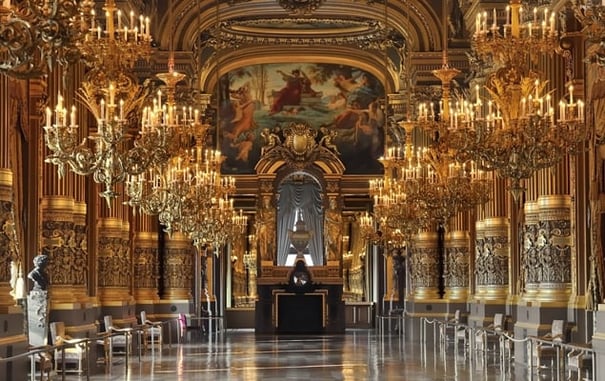Step foot into the spectacular Opera Garnier, the world’s most famous opera house. This striking example of the Beaux Arts style of architecture is a true feast for the eyes and shows off the decadence of late 19th century Paris. Completed in 1875, it was the home of the Paris Opera for nearly 100 years and remains the primary venue in the city for ballet. Already famous based on its architectural merits, Gaston Leroux further immortalized Opera Garnier in his novel The Phantom of the Opera, which Andrew Lloyd Webber later adopted into the popular musical. Lavishly decorated both inside and out, Opera Garnier generously opens its doors to visitors who flock from all around the world to see its marble Grand Staircase, golden Grand Foyer and enormous bronze chandelier in person.

Visiting
The Opera Garnier is situated in the 9th arrondissement of Paris, right next to the popular Galeries Lafayette Haussmann. The building is open for tours most days, but we recommend checking ahead of your visit just to be sure. The first thing you’ll notice as you approach the opera house is its extravagant facade, which took nearly 100 different craftsmen to complete. This overabundance of detail and decoration is indicative of the style of the late 19th century in Paris, a period where decadence knew no bounds. The Opera Garnier’s front facade alone features dozens of intricately carved sculptures. Take at look at the busts adorning the first and second floors and you might recognize Beethoven, Mozart and Bach.
Grand Staircase
Situated just beyond the main entrance to the Opera Garnier, its Grand Staircase is a fitting focal point for this beautiful building. The staircase is nothing short of spectacular, and features marble in luxurious shades of red, green and cream from Sweden, Italy and France. Not to be outdone, the oversized candelabras anchoring and illuminating the stairs are works of art all on their own. As you ascend the staircase, don’t forget to look up at the colorful fresco and skylight above.
Grand Foyer
The Opera Garnier’s Grand Foyer glows in warm hues of gold and is the very definition of decadent. Even more opulent than the Hall of Mirrors at the Palace of Versailles, the Grand Foyer stretches over 500 feet. This was the place to see and be seen in late 19th century Paris. The foyer was recently restored to its former glory and features two enormous fireplaces at each end. On the ceiling there is a beautiful fresco depicting important moments and events in the history of music dating back to the 1870s.
Auditorium and Chandelier
With space to accommodate 1,979 patrons and 450 performers, the Opera Garnier remains one of the largest opera houses in Europe nearly 150 years after its completion. In the center of the room hangs its famous chandelier. Made from crystal and bronze, this elaborate piece of artwork weighs an incredible seven tons! After it was installed there was concern that it partially obstructed the view of the stage and of the auditorium’s ceiling frescos, but over time it has become a treasured part of the opera house.

History
Before the Opera Garnier, the Salle Le Peletier was the primary opera house in Paris. On the evening of 14 January 1858, an assassination attempt was made on Napoleon III as he arrived by carriage to the Salle Le Peletier with his wife. The next day, he announced that a new opera house, with a more secure entrance, should be built. The design for this new opera house was chosen by a competition, and 35-year-old Charles Garnier was proclaimed the winner in 1861. Garnier was a relatively unknown architect at the time, but he impressed the judges with the grandeur and scale of his design.
The initial construction of the opulent, detailed and expensive Opera Garnier proceeded relatively quickly. The facade of the building was completed in six years, just in time for its unveiling for the 1867 World’s Fair in Paris. It would take another eight years to complete the opera house’s extravagant interior as construction slowed due to the Franco-Prussian War. The Opera Garnier opened in 1875 to much fanfare, but Napoleon III died two years prior and was never able to see the completed masterpiece in person.

Paris Perfect's Personal Tip
Entry to the Opera Garnier is included in the Paris Pass, along with about 60 other major museums and attractions in and around Paris. If you’d like to attend a performance at the Opera Garnier, you can view a schedule events at the official website of the Opera de Paris.

Essential Information
- Address: 8 Rue Scribe, 75009 Paris, France
- Closest: Metro: Opéra
- Website: https://www.operadeparis.fr/en/visits
- Opening Times: Open 10.00am to 5.00pm most days. Please check the official website for more details.
Sign up for our Vacation Perfect newsletter and real estate updates.
